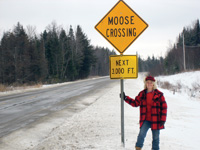From the editor: Moose and the Higgs boson
In the snowy twilight of an early winter evening I was driving south on Vermont Route 14 when two moose emerged from the woods and crossed the road a few yards in front of my car. Immediately, I thought of the Higgs boson.
As with the Higgs, signs and portents of moose are everywhere hereabouts. Decades of moose hunting have established their most likely habitat, and motorists are well warned of the spots where they can expect to detect them. Higgslike, the moose are surely out there, but Higgslike they remained unseen, at least by me.
Suddenly, they appeared in my headlights, two huge, dark shapes, with their improbably majestic antlers and long, long legs, ambling across the road.
Unlike the art of Higgs detection, automotive moose detection is very often fatal for the detector, although rarely for the moose. Fortunately, I had been driving slowly on the snowy road, so I had time to stop. Heart pounding, I watched the enormous animals cross the road and disappear into the woods on the other side.
Well, now Ive seen them. Moose exist. And like the Higgs, or so I thought in the twilight, these magnificent creatures are deeply, primally connected to the beauty and mystery of nature. There was no one behind me on the highway, so I waited a minute or two, thinking these thoughts, before I drove on.
And turned on the car radio, where an interview was in progress with a young innovator, a science whiz and musician, who at the age of 17 had already made a contribution to science and technology. While practicing the piano, the Pennsylvania high-school student noticed that certain chords caused the strings of a banjo hanging on the wall to resonate. Inspired by that observation, she developed an acoustic detector for hidden land mines.
To wrap up the interview, the host asked this remarkable young woman about her plans and ambitions.
I m not exactly sure what I want to do with my life, she said, but Ive told people before that my dream is to do particle physics and work at CERN in Switzerland, but definitely I want to do something in science.
A thrill: talented, idealistic young Americans still dream of doing particle physics. A pang: they must dream of doing it far from their own country. Not that theres anything wrong with CERN or Switzerland, although they do not, I believe, have moose.
Perhaps this is the year the Higgs boson will turn up in the headlights. And may dream-worthy particle physics flourish anew here at home!
Meanwhile, drive carefully and watch out for moose.
Judy Jackson, Editor-in-chief
Click here to download the pdf version of this article.



